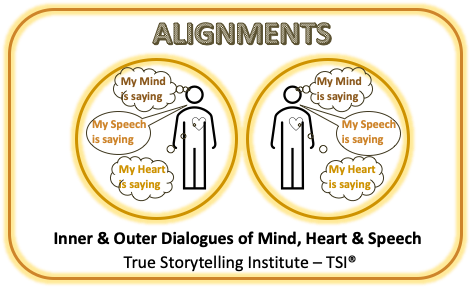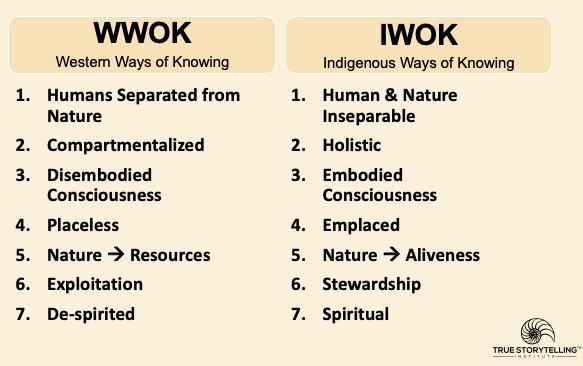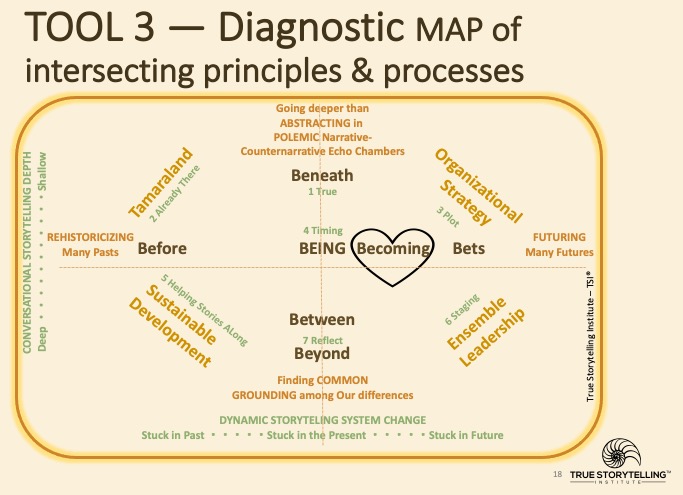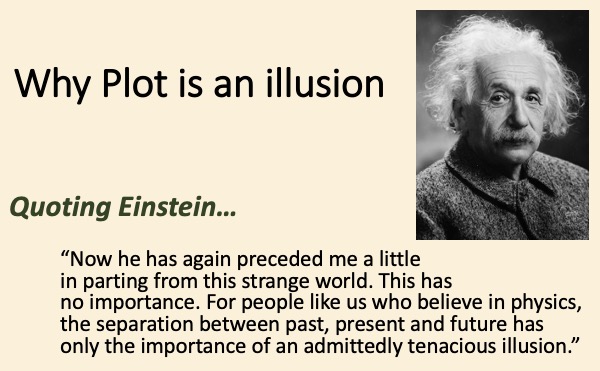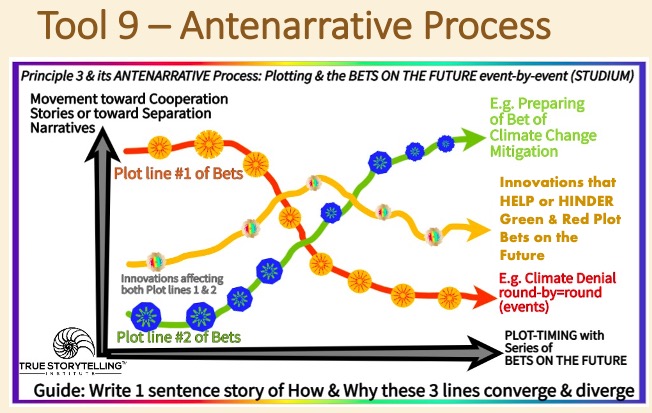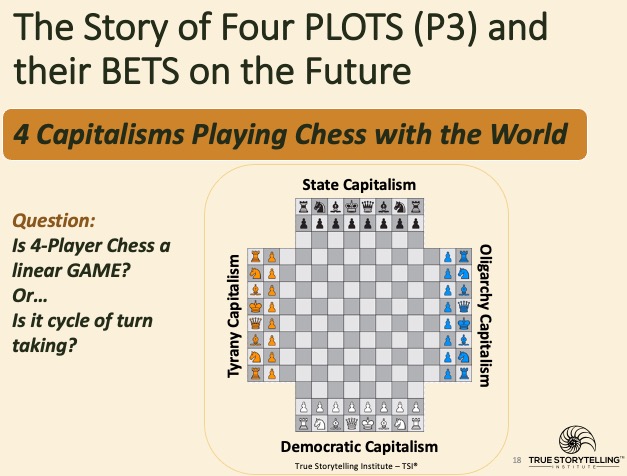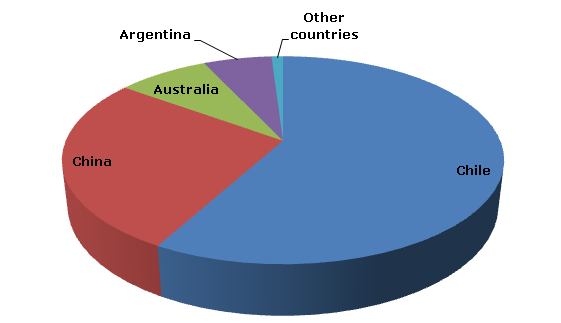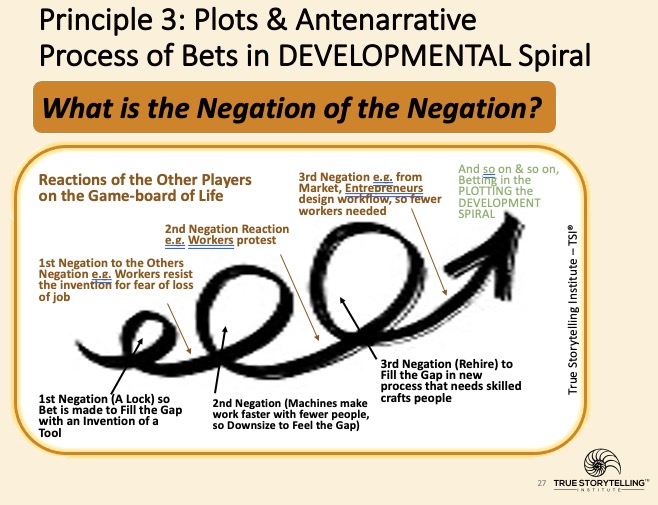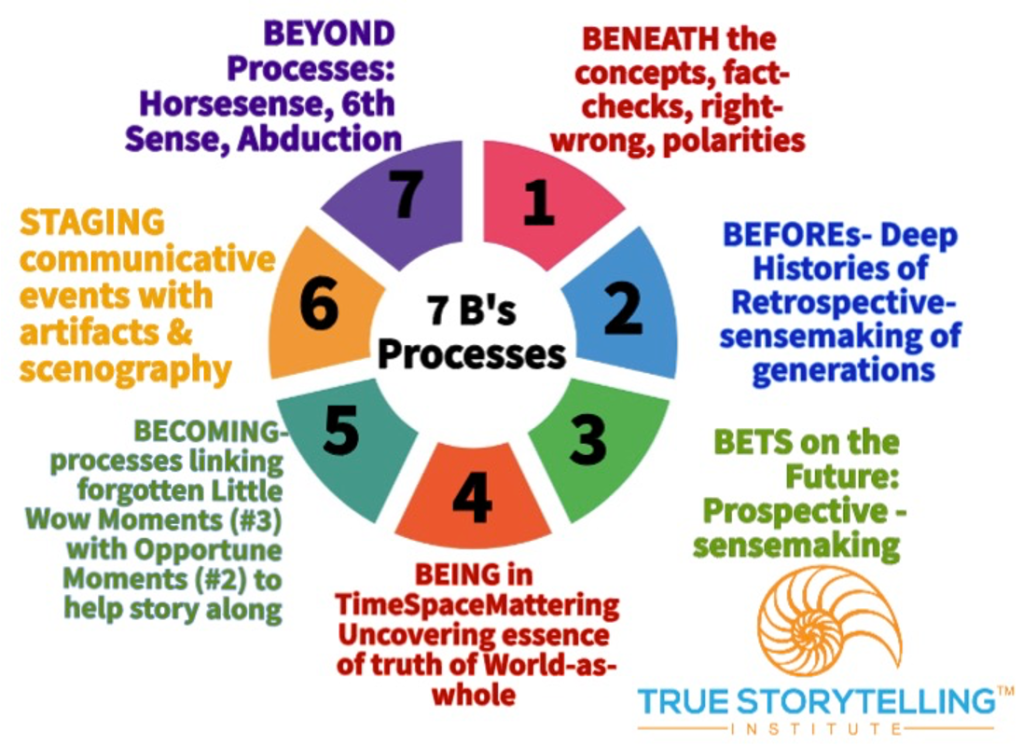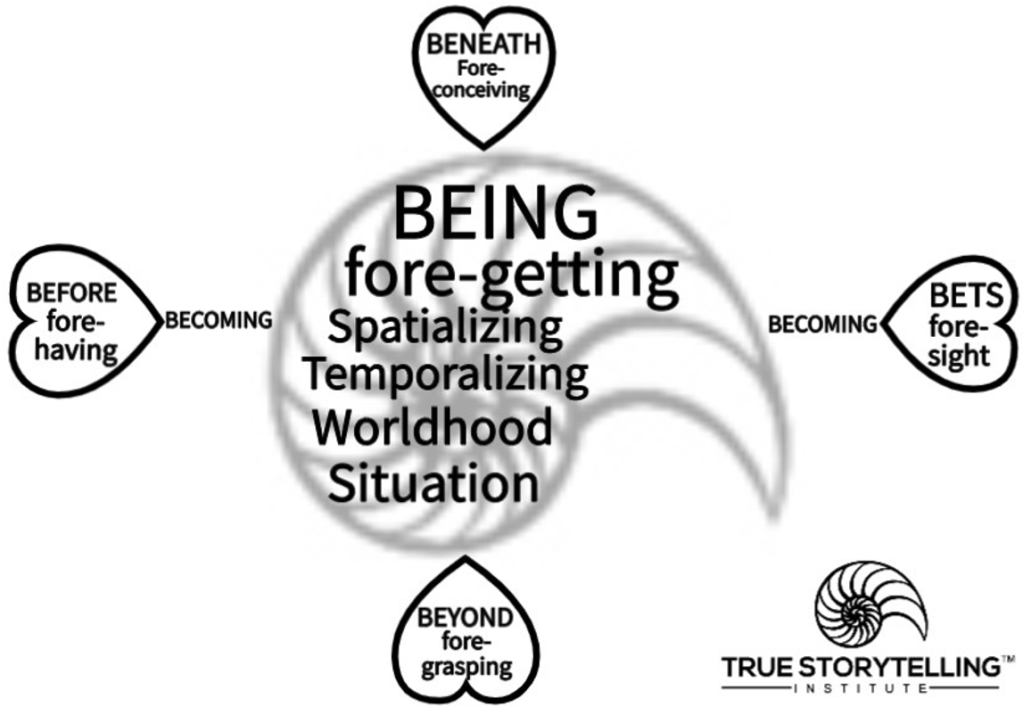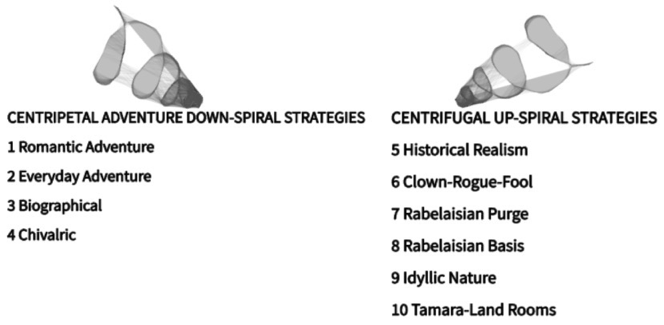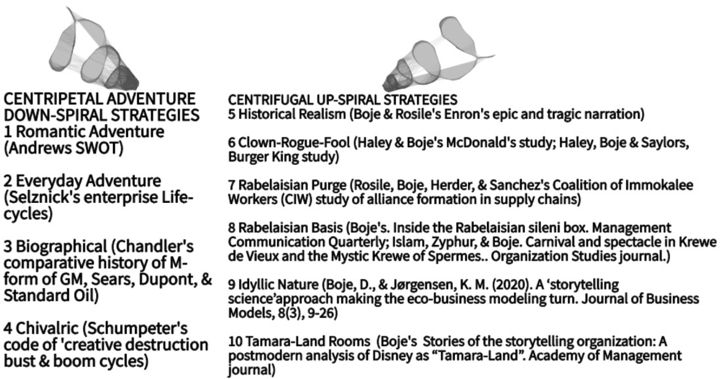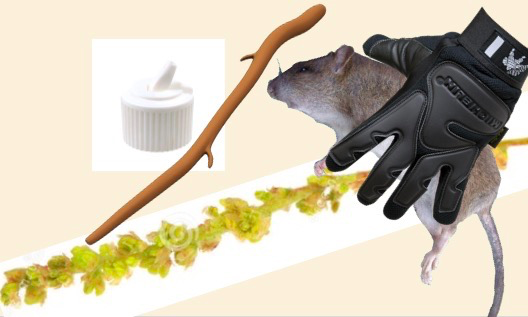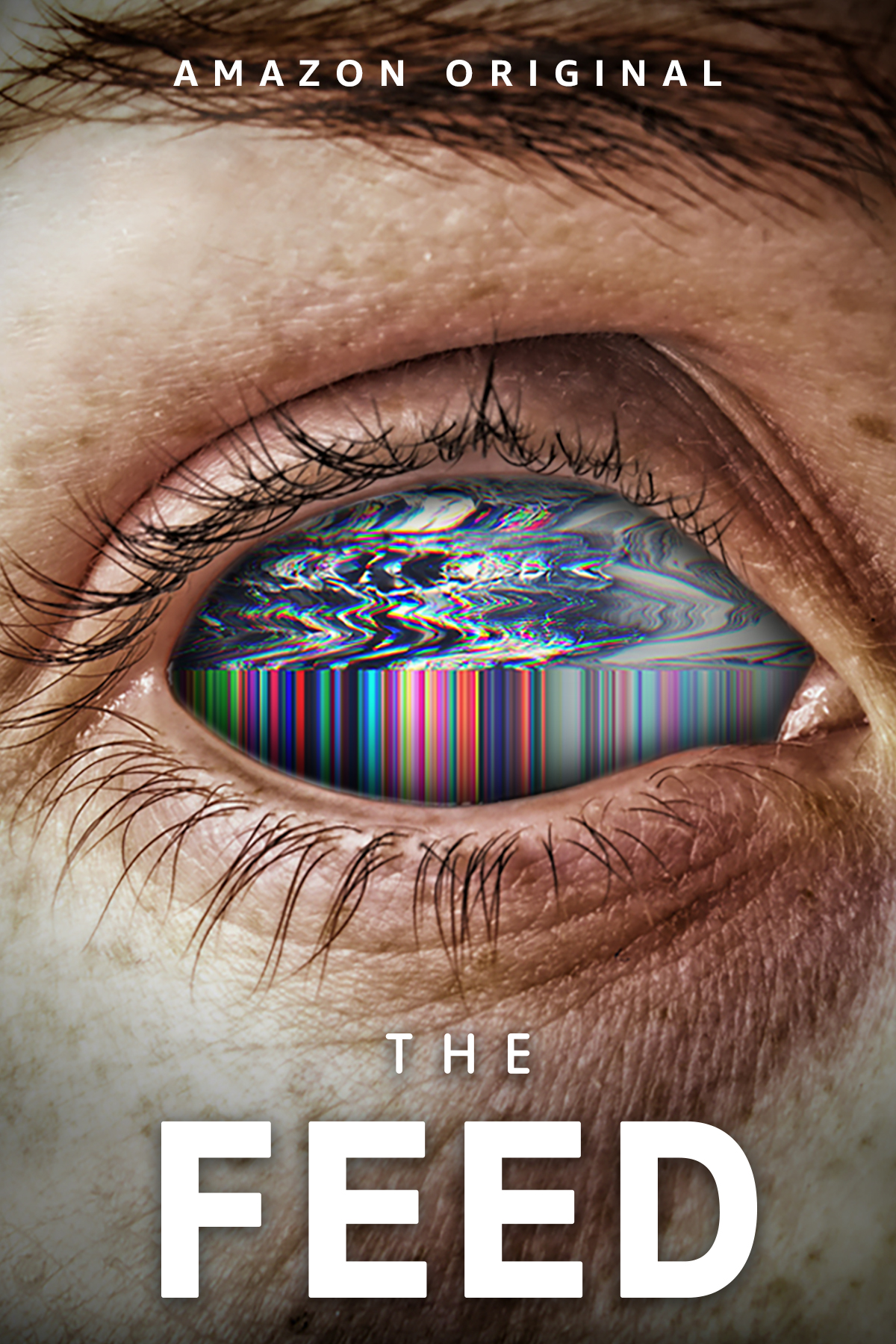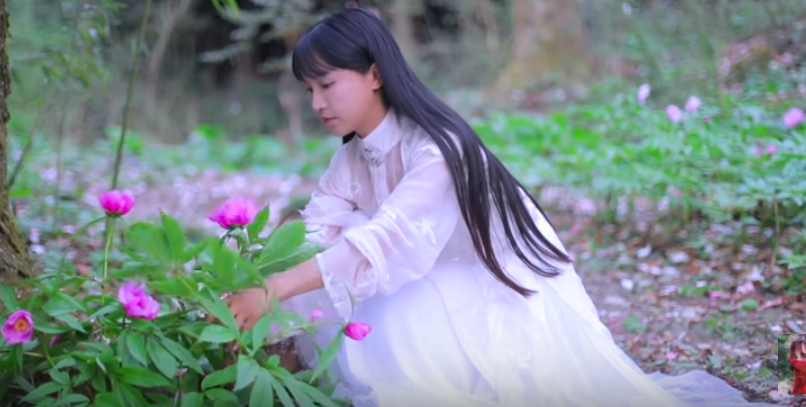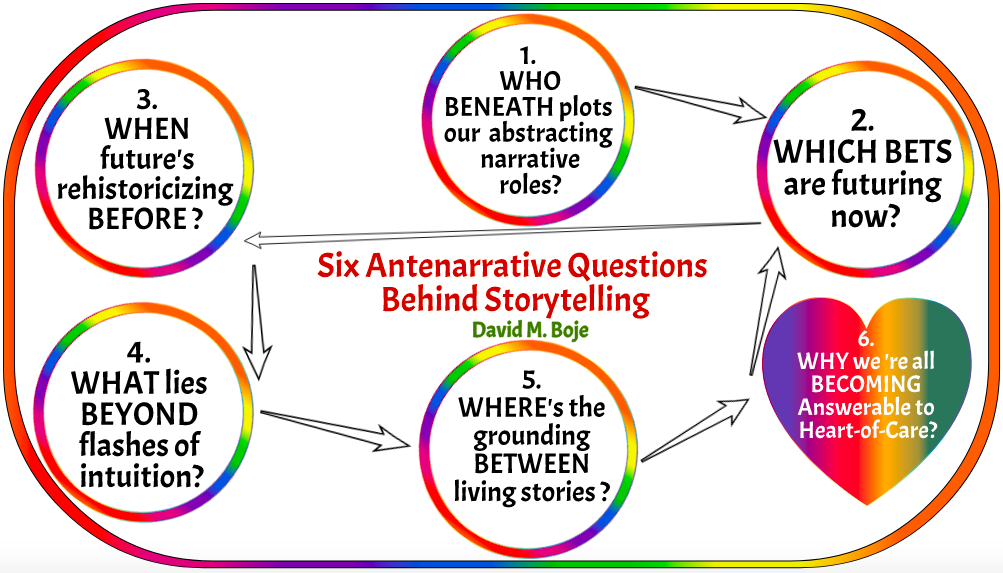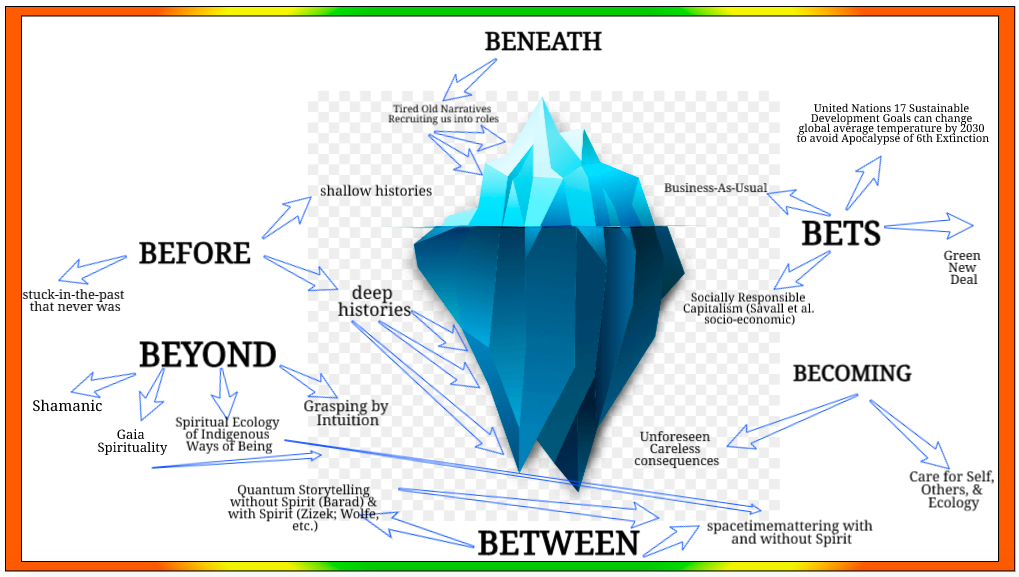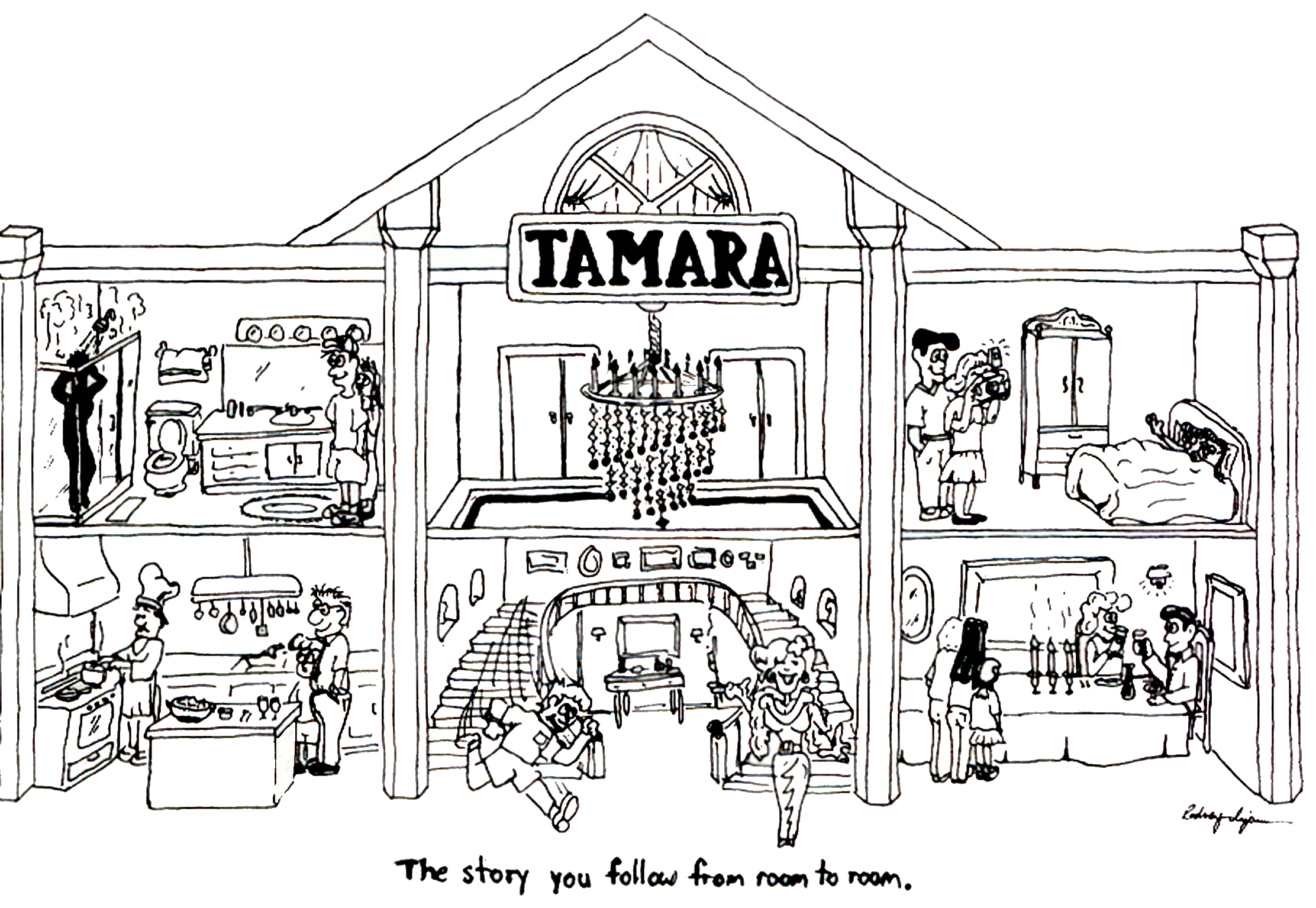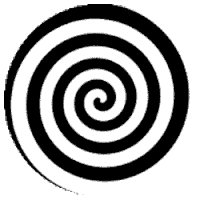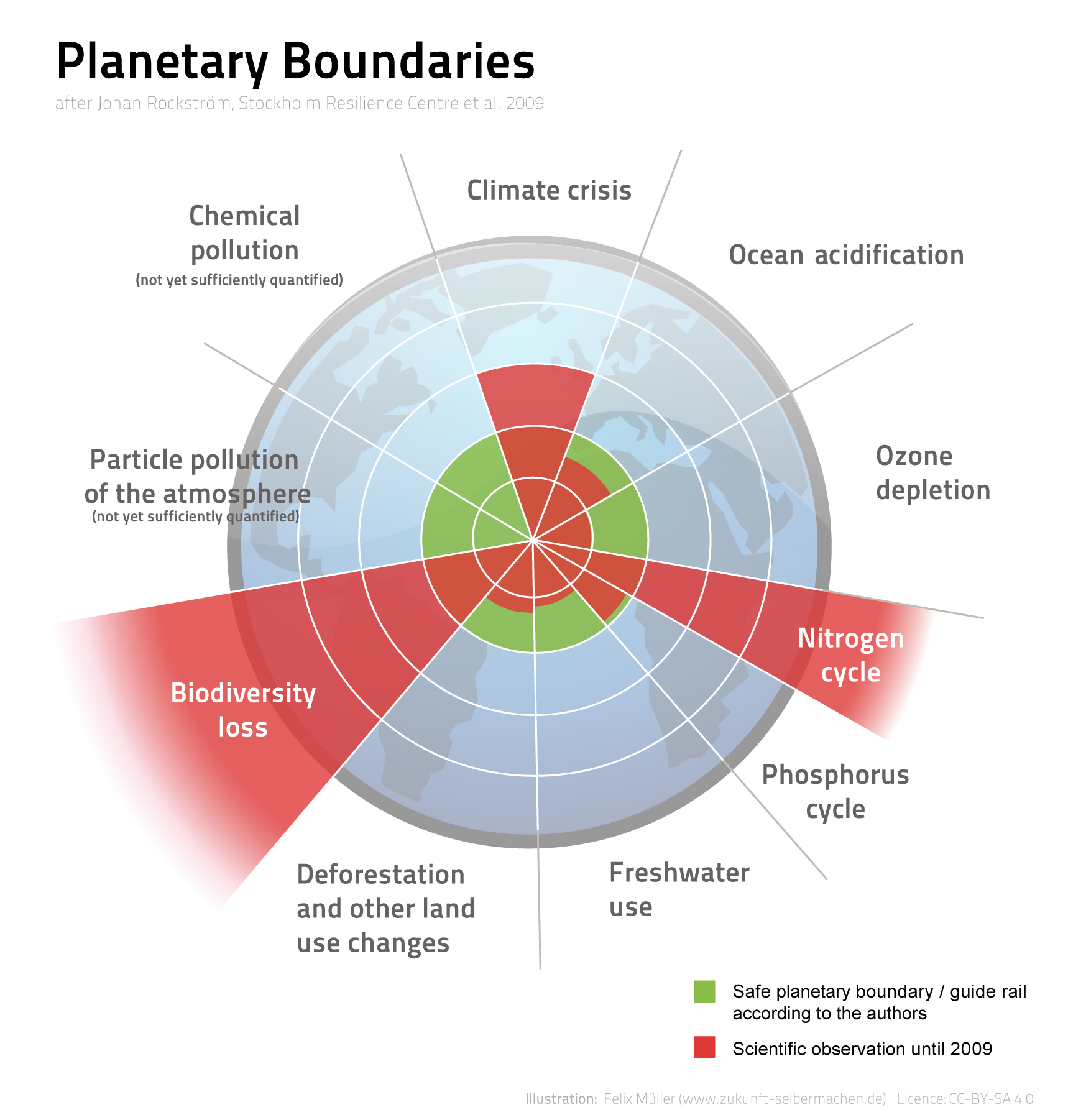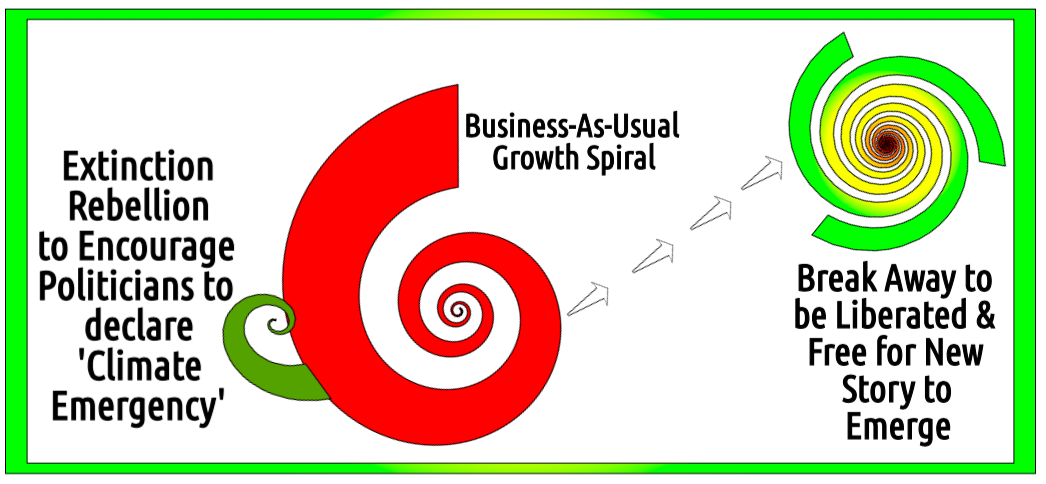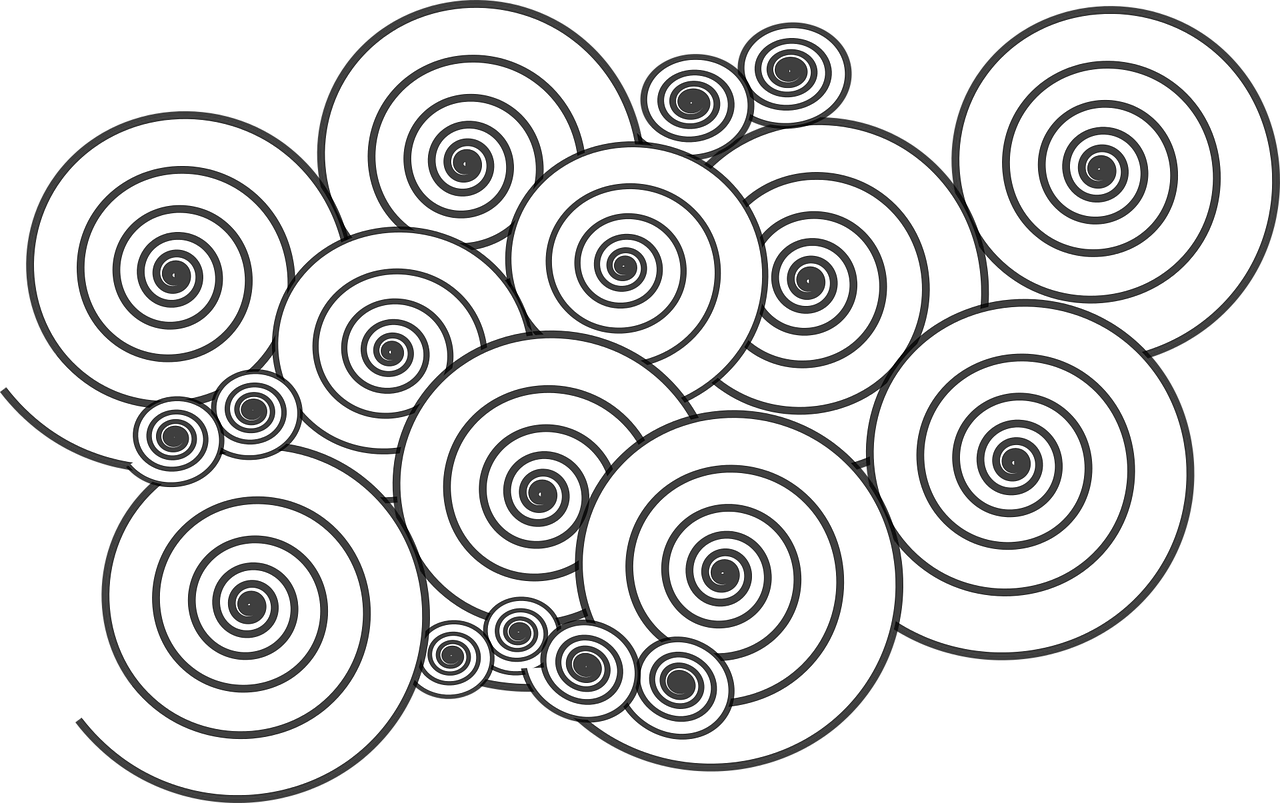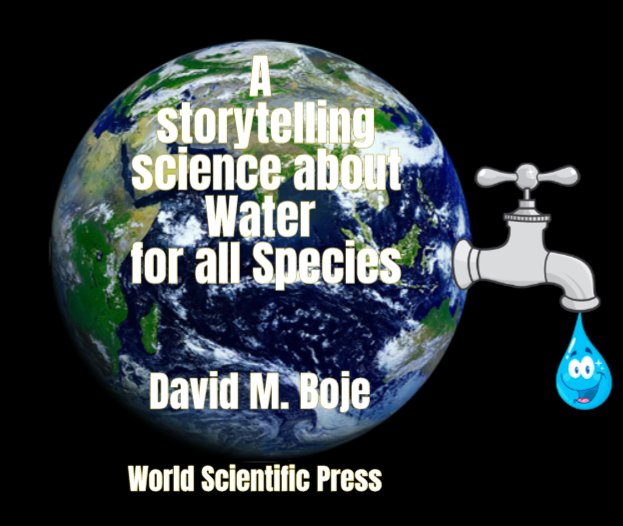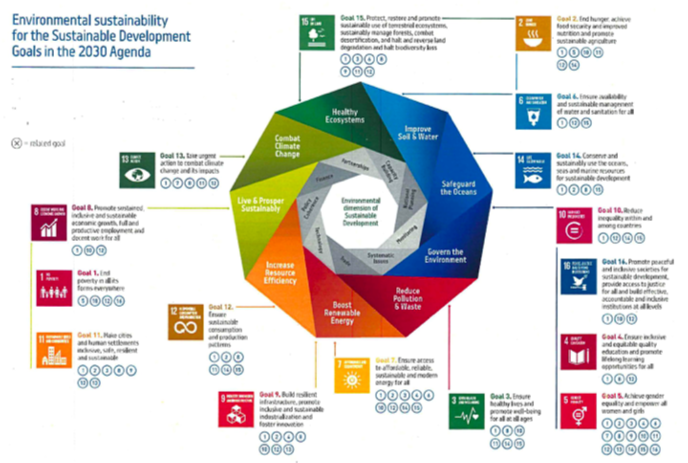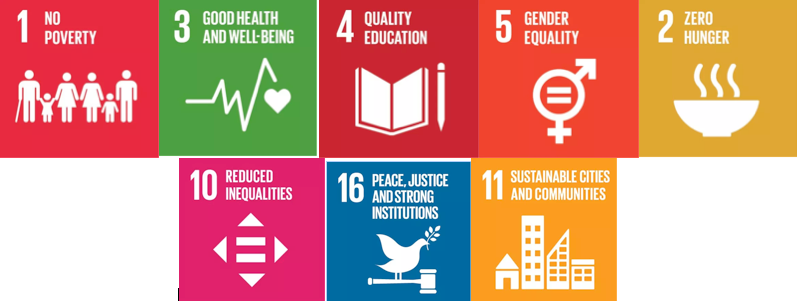What Story Has Water To Tell? by David M. Boje May 17 2020
After being a storytelling researcher 40+ years, I have come to the conclusion, most westerns in Europe and US, are the least aware of the most important part of their existence, water! Most Western Ways of Knowing (WWOK) do not have the reverence for life of Indigenous Ways of Knowing (IWOK). Water has a story, all its own.
“There are these two young fish swimming along and they happen to meet an older fish swimming the other way, who nods at them and says:
‘Morning, boys. How’s the water?’
And the two young fish swim on for a bit, and then eventually one of them looks over at the other and goes
‘What the hell is water?’” (David Foster Wallace, 2005, online).
Let me add a few lines to the Wallace’s story.
The older fish says, ‘Water is an aliveness. Try living without it!’
And the two young fish looked at each other, and one said to the other:
‘What story does water have to tell?’
What is the point of this story? On the surface, the story tells us that like the younger fish, it’s hard for us to see and talk about one of the most important realities of our existence on Earth, ‘water’. To the older and wiser fish, there is always a deeper meaning to the story. In IWOK storytelling, water is a character, a storyteller, a living entity. To WWOK water is a ‘resource’, an object that is inanimate, just two hydrogen molecules fused to an oxygen molecule, nothing more. More on this point in book I am writing on water storytelling.

It is past time for storytellers get begin to list to the story that water has to tell (Boje, in press, Storytelling Interventions in Global Water Crisis (Download book, in process, stays online only till published). In both WWOK and IWOK, earth has a fixed world water supply that recirculates that same water that has existed since the big bang. Worldwide, water supply exceeds demand.
“Water is a finite resource: there are some 1,400 million cubic kilometers on earth and circulating through the hydrological cycle. Nearly all of this is salt water and most of the rest is frozen or under ground. Only one-hundredth of 1 percent of the world’s water is readily available for human use” (Water A Finite Resource)
Is there Another Deeper Meaning to the Fish Story?
What if water is more than H2O? What if like the older fish says, water is ‘aliveness’ itself? What if, water is has a story t tell? In IWOK storytelling water is revered as source of life, as aliveness, as water spirit.
“Water is the most life sustaining gift on Mother Earth and is the interconnection among all living beings. Water sustains us, flows between us, within us, and replenishes us. Water is the blood of Mother Earth and, as such, cleanses not only herself, but all living things. Water comes in many forms and all are needed for the health of Mother Earth and for our health. The sacred water element teaches us that we can have great strength to transform even the tallest mountain while being soft, pliable, and flexible. Water gives us the spiritual teaching that we too flow into the Great Ocean at the end of our life journey. Water shapes the land and gives us the great gifts of the rivers, lakes, ice, and oceans. Water is the home of many living things that contribute to the health and well-being of everything not in the water” (Assembly of First Nations – Honoring Water).
Water is the ‘Place’ of ‘Aliveness’
In our storytelling conversations at the Gaia Storytelling Lab of European School of Governance, we listen to the story water has to tell. For example, water is aliveness, what Jane Bennett (2010) calls ‘vibrant matter.’[1] Vibrant matter has its onto-story (meaning ontological-story) to tell, its story of existence in a quantum storytelling. In onto-story, we observe that every living biotic thing has water sustaining its life in some place of existence on the planet. Water is alive in the mountains and the trees because water is essential to the aliveness of ‘place.’ I live in the desert of New Mexico, on the east Mesa of Las Cruces. We get 10 inches of rainfall a year, and most of it comes in a few downpours, that run off the dried parched land, carrying what’s left of the topsoil away, only the cactus, the mesquite and greasewood can grow here. Places without a few inches of rainfall a year, are lifeless. As I observe the horny toad, the diamondback rattle snake, the tranchila, and scorpion, as well as the bees, ants, and quail, I hear water’s story of aliveness. I also observe the water rights disputes becoming water wars between New Mexico, Colorado, and Texas, and with Mexico, as there is not enough freshwater in the ground aquifers, or the Rio Grande River, to go around. Cities are growing, demanding agriculture surrender water ownership, while meanwhile wildlife riparian soil gets left in water stress or with no water at all, as ‘place’ gives way to more and more development.
How can we tell water’s aliveness-story? Listing these facts about the finiteness of water in the hydrological cycle is less effective than just telling the story of aliveness. You often see these facts” Earth has 332.5 million cubic miles of water, 96.5% of it is saline (Na Cl, aka sodium chloride) but forget the story they tell. More facts don’t help much: 3.5% is fresh drinkable water, but 68% of that freshness is trapped in ice and glaciers, while about 1/3rd is in the ground, which leaves only 2% of freshwater in the rivers, lakes and streams. Here’s a story about water-aliveness.

“Are we drinking Cleopatra’s bath water?”
“When biologists speak about Cleopatra’s bathwater, what they are playfully illustrating is that the Earth is mainly a closed loop. What’s here today was generally here yesterday. So that cup of tea you’re drinking could once have been Cleopatra’s bathwater!
But if Cleopatra were to bathe in the Earth’s waters today, her skin would crawl and palace heads would roll. Our booming human population is massively disturbing the planetary waters, polluting and straining the ecology of water everywhere” (Kenny Ausubel, undated, online).
The moral and practical wisdom of the Cleopatra’s bath water story and this IWOK notions of water is since we share the finite water that has existed since the beginning of earth’s existence, and that same finite water circulates in the global water cycle, hopefully revitalizing and filtering out the yucky bits of the bath, we bathe in each other’s water, drink each other’s water, just as we breathe each other’s air. We therefore might be advised to revere water, to honor the life-giving role of water, and the cleansing role of the water cycle itself as a living system. What about the recirculating toilet water in the global water cycle?

Are we already drinking each other’s toilet water?
Some storytelling is exaggeration. But it’s a fact ‘all water is dinosaur pee!’ On a planetary scale this one is ‘True’ with a capital-T because dinosaur pee persists in the global water cycle and is recirculating with every kind of water.
Yes, metropolitan cities have wastewater treatment. They also receive their water from upstream and discharge it into the hydrological cycle to be received by other cities downstream. The water supply is not growing in that cycle. The moral of the story: Global water is a closed system with a fixed and finite amount of water circulating in the hydrological cycle, which includes even the flush.
Water has a story to tell, but do we have the awareness to listen?
We are so surrounded by water it is too easy to take it for granted. Again, we can list, more facts, but does this help human understanding of the situation we are in? Water is essential to all life. Our bodies are 85% water when we are born and at age 72, my body is 55% water. I can survive a week without food, but after only three days without water, my body organs shut down for good, and on the fourth day, I’m a goner. The point is ‘water is life’ for every living thing on Earth.
Think of water supply and demand like your bank account. You make deposits and withdrawals, leaving your account balance. We are already overdrawn!
Water Bets Being Made on the Future
My storytelling research, since 2001, has been developing prospective sensemaking, I call ‘antenarrative’ by studying ‘bets on the future.[2] In storytelling we are told and retold, the bets being made about the future of water. A decade from now:
“According to the U.S. Intelligence Community Assessment of Global Water Security, by 2030 humanity’s “annual global water requirements” will exceed “current sustainable water supplies” by 40%” Source
“… If current usage trends don’t change, the world will have only 60 percent of the water it needs in 2030” Source (Seametrics website).
Earth’s freshwater supply is unevenly distributed on the planet, and is no longer keeping up with demand. The United Nations predicts that by the year 2025, 30 nations will be water scarce. UN predicts by 2030, half the world’s population will live in places with ‘high water stress.’ “Hydrologists regard countries where indigenous water supplies average less than 1,000 cubic meters per person per year as ‘water-scarce’” (Water-A Finite Resource). Warmer air from climate change (aka global heating) means more water vapor is stored in the air, more ice and glacier melts, as the soil gets hotter, demanding more water.
Here is another parable-story about how unaware humankind is about water.
Earth’s water supply is dwindling as ‘drought-like conditions become the new normal’ (Sean Keach, Dec 17, 2018).
“Climate change is producing more rain, but the world’s water supply is shrinking – and now scientists know why.
Scientists have warned that global warming is drying out the planet’s soil, which could create a world where ‘drought-like conditions become the new normal.’”
“…Less water into our rivers means less water for cities and farms. And drier soils means farmers need more water to grow the same crops.
“Worse, this pattern is repeated all over the world, assuming serious proportions in places that were already dry.”
Will water become more expensive than oil?
“It raises a particularly dystopian question: could water, one of the world’s most abundant resources, ever be more expensive than one of its rarest, oil?
“It already is,” says Dr Brian Cook, a researcher in Development Geography.
He’s right.
In Australian supermarkets, a bottle of Mount Franklin Spring Water costs around $3.33 a liter. At the pumps in mid-February 2018, the average cost of a liter of unleaded petrol is less than half that, at $1.38.
The end of days already stalks our supermarkets.” (Ed Mccracken, March 7 2018).
As the world’s fixed water supply dwindles, water capitalism turns it into a privatized commodity. Water speculators buy land with freshwater rights, waiting for water to become the new oil, and then just cash in. The consequences of our lack of water awareness, like the two young fish swimming, they do now know ‘what is water?’
Water has a story to tell. It is a story of water-aliveness, the agential character of water in the aliveness of this planet. Using living freshwater to make plastic water bottle products is a waste of aliveness.
Storytelling With More than Statistics
Time to make my point. Statistics don’t communicate as well as a storytelling demo. For example, I could tell you, that the USA consumes 50 billion plastic water bottles a year. 23% head to recycling, but 38 billion don’t go to recycling, and then only about 9% actually gets recycled, because China is no long taking them, and because it costs $$$ to sort the bottles, shred them, wash them, heat them to sanitize, then melt into pellets and sell to beverage companies. Your eyes glaze over, you are reaching for your cell phone, because humans are storytelling animals, not fact repositories.
I do this demo at conferences to tell the water and oil story, behind the water bottle story.
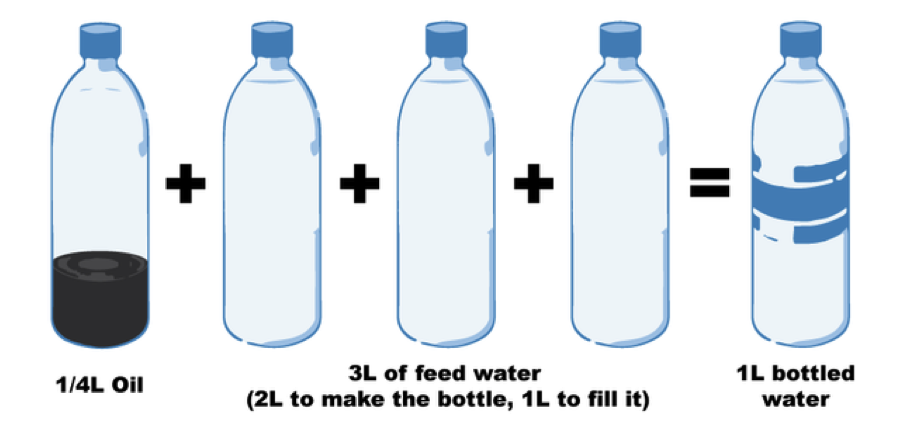
To wake up an audience, I fill several water bottles with feed water (the virtual water in the supply chain to make them) plus I fill a ¼ liter of oil on a fourth bottle. That is a way to do visual storytelling of the waste of bottled water production and consumption, at a time when the water demand exceeds water supply on the planet.
As water commodification continues to escalate, billions of gallons of water are used to make the billions of gallons of water in water bottles. It takes 3 feed waters to make 1 final bottle of water, and lots of oil. 50 billion USA plastic water bottles is 17 million gallons of oil. You have to include the virtual water it takes in the plastic water bottle supply chain. It takes 6,000 mega joules of electricity for each barrel of oil, and with all the oil for 40 billion bottles that is 106 billion mega joules of electricity, which is how the 25% oil calculation is based on.
More at https://davidboje.com/water
[1] Bennett, J. (2010). Vibrant matter: A political ecology of things. Duke University Press.
[2] Boje, D. M. (2001). Narrative methods for organizational & communication research. Sage. Available Research Gate

